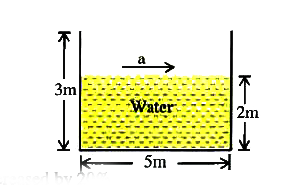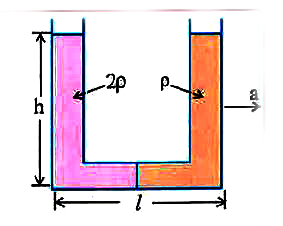A piece of copper (sp. gravity 8.8g/cm2) having an internal cavity weighs 264g in air and 221g in water? Find the volume of the cavity?Solution in Telugu
13cc
Topper's Solved these Questions
- FLUID MECHANICSBook:AAKASH SERIESChapter:FLUID MECHANICSExercise:Numerical Exercise (LEVEL-2)
Explore 18 Videos
- FLUID MECHANICSBook:AAKASH SERIESChapter:FLUID MECHANICSExercise:Questions for Descriptive Answers
Explore 14 Videos
- FLUID MECHANICSBook:AAKASH SERIESChapter:FLUID MECHANICSExercise:Very Short Answer Type Questions
Explore 28 Videos
- EXPANSION OF SOLIDS Book:AAKASH SERIESChapter:EXPANSION OF SOLIDS Exercise:Questions for Descriptive Answers
Explore 5 Videos
- FRICTION Book:AAKASH SERIESChapter:FRICTION Exercise:ADDITIONAL PRACTICE EXERCISE PRACTICE SHEET (ADVANCED) (MORE THAN ONE CORRECT ANSWER TYPE QUESTIONS)
Explore 1 Video
Similar Questions
An open rectangular ank 5m×4m×3m high containing water upto a height of 2m is accelerated horizontally along the longer side (a) Determine the maximum acceleration that can be given without spilling the water.
(b) Calculate the percentage of water split over, if this accelerationis increased by 20%
(c ) If initially the tank is closed at the top and is accelerated horizontally by 9m/s2, find the gauge pressure at the bottom of the front and rear walls of the tank.

View SolutionA U-tube of base length I filled with same volume of two liquids of densities ρ and 2ρ is moving with an acceleration a on the horizontal plane. If the height difference between the two surfaces (open to atmosphere)becomes zero,then find height h

View SolutionWhy canals are constructed in 'V' shape? Explain.
View SolutionThe length of an iron rod is measured by a brass scale. When both of them are at 20∘C, the length is 80 cm. What is the length of the rod at 100∘C as measured by the scale at 100∘C? The coefficient of linear expansion of brass and iron are 24×10−6(C∘)−1and18×10−6(C∘)−1 respectively.
View Solutionif the man can move with maximum acceleration a1anda2 relative to the trolley car in forward and backward directions, respectively then :
View SolutionA piece of gold (rho=19.3 g//cm^(3)) has a cavity in it. It weights 38.2g in air and 36.2g in water. The volume of the cavity in glold is
View SolutionAn iron casting has a number of cavities in it. It weighs 6000N in air and 4000N in water. Determine the total volume of all the cavities in the casting. The density of iron (without cavities) is 8.0g/cm3,ρw=Ig/cm3.
View SolutionA metal block having an internal cavity weight 110 g in air and 80 g in water. If the density of metal is 5.5 g//cc, then the volume of cavity is :
View SolutionA piece of gold weighs 10g in air and 9g in water. What is the volume of cavity? (Density of gold = 19.3 g cm^(-3) )
View SolutionA steel block having an internal cavity weighs 234g in air and 197g in water. If the density of steel is 7.8gcm−3 then the volume of the cavity is
View SolutionA metallic sphere with an internal cavity weighs 40 gwt in air and 20 gwt in water. If the density of the material with cavity be 8g per cm^(3) then the volume of cavity is :
View SolutionA piece of copper having an internal cavity weights 264 g in air and 221 g in water. Find the volume of the cavity. Density of copper is 8.8 g//cm^(3)
View SolutionIn previous problem if the piece is made of pure gold with some air cavities In it. Calculate the volume of the cavities left that will allow the weights given in that problem.
View SolutionA Piece of brass (alloy of zinc and copper) weighs 12.9 g in air. When completely immersed in water it weighs 11.3 g . What is the mass of copper contained in the alloy ? Specific gravity of zinc and copper are 7.1 and 8.9 respectively.
View SolutionA piece of gold weighs 50 g in air and 45 g in water. If there is a cavity inside the piece of gold, then find its volume [Density of gold = 19.3 g/cc].
View Solution
